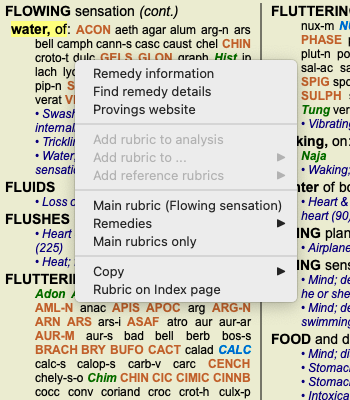Getting started
Intuitive design
Complete Dynamics is designed to be used intuitively, by those who have a professional background in homeopathy.
Some features of the program can be used much more effectively if you learn a few tricks.
This is particulary true for using the Jump to field, and the Find field. Just read the help sections on those subjects to learn about their powerful possibilities. It's worth a few minutes of your time...
Using the mouse
Your computer mouse or track pad can be used to quickly achieve common tasks or call up information.
When the mouse cursor changes its shape into a small hand  , clicking will perform some action on the item the cursor is on. For example: clicking on a reference will instantly jump to the rubric referred to.
, clicking will perform some action on the item the cursor is on. For example: clicking on a reference will instantly jump to the rubric referred to.
In some situations, double clicking can be used to obtain detailed information about the item clicked on. For example: double clicking on a remedy abbreviation in the book will bring up a dialog with detailed information.
The scroll wheel is used to quickly move between the rubrics of the book. If your mouse or track pad supports horizontal scrolling, this feature is used for quickly flipping through the book pages.
Using the keyboard
The keyboard can be used to quickly access most common features, highly reducing the need to switch between using mouse and keyboard.
You can use the keyboard to quickly navigate through the book, or access menu options via keyboard shortcuts. If you open the menu, you will see the keyboard shortcuts displayed alongside the menu options.
For an overview of the keyboard shortcuts, see Keyboard shortcuts.
Popup menus
In many situations, popup menus provide quick access to functions. Just right-click and the menu opens (Mac: ctrl-Click).
Example:

Index tabs
The main modules of Complete Dynamics are accessible through so called index tabs. You activate the module by clicking on the tab, selecting it from the menu (View option), or with a keyboard shortcut.
In the Browser edition these are Index, Book and Find.

The Index module provides quick access to the book's chapters, using both a textual and a graphical representation. See help section Index module for details.
The Book module shows the repertory. You can read it like a printed book, but also view it in a more condensed form. See help section Book module for details.
The Find module offers powerful functionality for finding rubrics and remedies in the book. See help section Find module for details.
Button bar
At the top of the screen, a button bar provides quick access to commonly used functions.

Click on a button to activate the function, move the mouse over it to get a short description of what it does.


